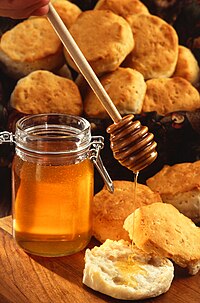
Photo from wikipedia
Simple Summary Varroosis caused by the ectoparasitic mite Varroa destructor has been the biggest threat to managed bee colonies over recent decades. Chemicals available to treat the disease imply problems… Click to show full abstract
Simple Summary Varroosis caused by the ectoparasitic mite Varroa destructor has been the biggest threat to managed bee colonies over recent decades. Chemicals available to treat the disease imply problems of resistance, inconsistent efficacy, and residues in bee products. Recently, alongside novel compounds to defeat the pest, lithium chloride has been found to be effective. In this study, we found that lithium treatments leave beeswax residue-free. The possibility of decontamination in adult bees, bee bread, and uncapped honey was revealed. On the other hand, ripe honey was found to be affected by lithium administered via feeding. Case studies are necessary to uncover the level of exposition in harvested honey to estimate its potential risk once it becomes a registered veterinary medicine. Abstract The biggest threat to beekeeping is varroosis caused by the mite Varroa destructor. Chemicals available to treat this fatal disease may present problems of resistance or inconsistent efficacy. Recently, lithium chloride has appeared as a potential alternative. To date, the amount of residue lithium treatments may leave in honeybee products is poorly understood. Honeybees were fed with 25 mM lithiated sugar syrup, which was used in earlier studies. The accumulation and elimination of the lithium were monitored in bees and their products for 22 days. Lithium concentration increased in the entire body of the bees to day 4 post-treatment and then recovered rapidly to the control level. Lithium exposure was found to affect uncapped honey in the short term (<16 days), but ripe (capped) honey measured at the end of the trial remained affected. On the other hand, lithium treatment left beeswax lithium-free. Based on these data, we propose that comprehensive research on harvested honey is needed to decide on the veterinary use of lithium.
Journal Title: Insects
Year Published: 2021
Link to full text (if available)
Share on Social Media: Sign Up to like & get
recommendations!